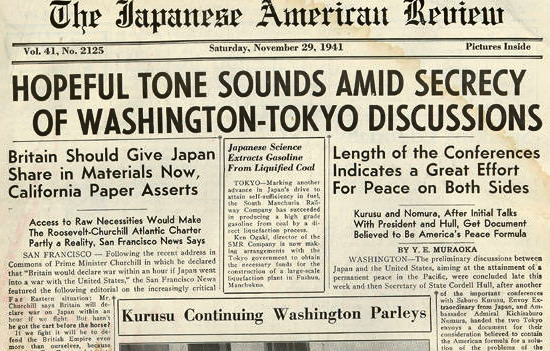Welcome to DU!
The truly grassroots left-of-center political community where regular people, not algorithms, drive the discussions and set the standards.
Join the community:
Create a free account
Support DU (and get rid of ads!):
Become a Star Member
Latest Breaking News
Editorials & Other Articles
General Discussion
The DU Lounge
All Forums
Issue Forums
Culture Forums
Alliance Forums
Region Forums
Support Forums
Help & Search
American History
Related: About this forumOn November 29, 1941, the "Japanese American Review" of NYC cited the "Hopeful Tone" of Washington DC talks.
“Hopeful Tone” of Washington DC talks cited by Japanese American Review of NYC, eight days before attack on Pearl Harbor, today 1941:
Link to tweet

Tue Nov 26, 2024: On this day, November 26, 1941, a Japanese task force departed Hittokapu Bay in the Kuril Islands en route to Hawaii.
Wed Nov 29, 2023: On November 29, 1941, the "Japanese American Review" of NYC cited the "Hopeful Tone" of Washington DC talks.
Wed Nov 29, 2023: On November 26, 1941, a Japanese task force departed Hittokapu Bay in the Kuril Islands en route to Hawaii.
Tue Nov 30, 2021: "Hopeful Tone" of Washington DC talks cited by Japanese American Review of NYC, November 29, 1941
2 replies
 = new reply since forum marked as read
Highlight:
NoneDon't highlight anything
5 newestHighlight 5 most recent replies
= new reply since forum marked as read
Highlight:
NoneDon't highlight anything
5 newestHighlight 5 most recent replies
On November 29, 1941, the "Japanese American Review" of NYC cited the "Hopeful Tone" of Washington DC talks. (Original Post)
mahatmakanejeeves
Nov 2024
OP
Dennis Donovan
(30,141 posts)1. The Japanese ambassador held that hopeful tone (knowing the attack was already planned) until 1pm on Dec 7, 1941
The attack took place before any formal declaration of war was made by Japan, but this was not Admiral Yamamoto's intention. He originally stipulated that the attack should not commence until thirty minutes after Japan had informed the United States that peace negotiations were at an end. However, the attack began before the notice could be delivered. Tokyo transmitted the 5000-word notification (commonly called the "14-Part Message" ) in two blocks to the Japanese Embassy in Washington. Transcribing the message took too long for the Japanese ambassador to deliver it at 1:00 p.m. Washington time, as ordered, and consequently the message was not presented until more than one hour after the attack had begun — but American code breakers had already deciphered and translated most of the message hours before it was scheduled to be delivered. The final part of the message is sometimes described as a declaration of war. While it was viewed by a number of senior American government and military officials as a very strong indicator negotiations were likely to be terminated and that war might break out at any moment, it neither declared war nor severed diplomatic relations. A declaration of war was printed on the front page of Japan's newspapers in the evening edition of December 8 (late December 7 in the United States), but not delivered to the American government until the day after the attack.
Mme. Defarge
(8,686 posts)2. Fascinating!